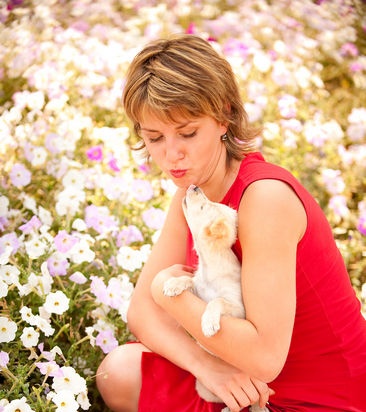|
 The dog is considered the first animal to be tamed by man. Thousands of years of living side by side with people unrecognizably changed not only the appearance of the descendant of the wolf and jackal (there are more than three hundred dog breeds!), But also the habits, character, the very "soul" of the animal. The dog is considered the first animal to be tamed by man. Thousands of years of living side by side with people unrecognizably changed not only the appearance of the descendant of the wolf and jackal (there are more than three hundred dog breeds!), But also the habits, character, the very "soul" of the animal.
 With much more reason than anyone else, a dog can be spoken of as a human creation. As applied to it, the definition of "four-legged friend" does not need any reservations. With much more reason than anyone else, a dog can be spoken of as a human creation. As applied to it, the definition of "four-legged friend" does not need any reservations.
Maxim Gorky called the dog the most honest friend of man. Charles Darwin suggested that dogs have something very similar to conscience. Paul Lafargue said the same: "... in a shepherd or guard dog, we meet a clearly expressed sense of duty and the ability to acknowledge our guilt ..."... Finally, the great Russian scientist I.P. Pavlov, who worked a lot and patiently with dogs, who knew them well, spoke of the dog as "Exceptional animal". “If this is not the highest animal, - he said, - (the monkey is higher on the zoological ladder), then the dog is the closest animal to man, like no other, is an animal that accompanies man since prehistoric times ".
The writer V. Veresaev recalled:
“We had a pug in our family ... Bela ... Humanly kind and surprisingly smart.
Once we started talking about the fact that Bela is very old, that we should have poisoned her. Sister Liza, a teenage schoolboy, remarked to us in a most serious way, frightened:
- Gentlemen, speak German, otherwise Bela will understand everything!
Sister Anya was offended by someone, she did not go to dinner, she lay on her bed and cried. Bela spun around the diners, squealing, wagging her tail and looking with pleading eyes. Everyone was very surprised: Bela never asked at the table: she knew that she was supposed to eat after dinner. We decided that I was very hungry, they gave me a chicken bone. Bela ran to the crying Anya and carefully laid the bone on her pillow ".
One shepherd dog in France has shown extraordinary intelligence. The shepherd was tending sheep in the mountains and suddenly fainted. His dog first of all drove the sheep into the stall, then returned to the pasture and dragged the owner down to the village. The alarmed peasants immediately sent for a doctor.
An American farmer in the city of Sacramento lost a dog in the crowd. The dog wandered for three whole years and still found a way home to the city of Scottsbluff; for this he had to overcome no less than 2000 kilometers! This incident inevitably brings to mind that in English dog means both "dog"and "Follow your heels"...
 History - both ancient and new - is replete with touching examples of the dog's selfless service to its owner, its selfless devotion, often reaching self-sacrifice. History - both ancient and new - is replete with touching examples of the dog's selfless service to its owner, its selfless devotion, often reaching self-sacrifice.
Has the author of the immortal Don Quixote a short story "Fraudulent wedding", in which the writer's fantasy gave the gift of speech and allowed two dogs to conduct a dialogue - Sipion and Berganse. Among other topics, the four-legged interlocutors touched upon the one that interests us:
“Sipion: As I have heard, we are praised and extolled for good memory, as well as for our gratitude and for our great loyalty, so it is even customary to portray us as a symbol of friendship. I think you happened to see (if you just looked) that on alabaster tombs, usually decorated with statues of the dead, in those cases when a husband and wife are buried, an image of a dog is placed between them, at the feet, as a sign that during their lifetime they observed friendship and unbreakable loyalty.
Berganza: I know that there have been loyal dogs in the world who rushed after the body of their master into the grave; some of them remained lying where the owners were buried, not moving from their place and not taking food, so that they would end here. ".
The great Spaniard Miguel Cervantes who wrote these lines lived in the 16th century. Three hundred years after him, the Russian polar explorer Georgiy Sedov made a heroic attempt to reach the North Pole. On the way, the brave sailor fell ill with scurvy and died on February 20, 1914. And so, when Sedov's companions lowered the body of their comrade into the ice grave, they could not take the leader of the team Fram away from her. The faithful dog never left his master - he died near his grave.
 Now fast forward another three decades to the present day. Before the Great Patriotic War, the family of Arkady Gaidar lived in the town of Klin near Moscow. Gaidar went to the front. Then Klin was occupied by the Nazis and destroyed the writer's house. When the Nazis were thrown away from Moscow and Gaidar's relatives returned to the house, they saw a sad sight. On the bare iron bunk, on which the writer himself used to sleep, lay now the dog Rogue, emaciated beyond recognition. For nothing in the world, the dog did not want to leave the bed, or at least take food. The crook died out on his master's bed ... Now fast forward another three decades to the present day. Before the Great Patriotic War, the family of Arkady Gaidar lived in the town of Klin near Moscow. Gaidar went to the front. Then Klin was occupied by the Nazis and destroyed the writer's house. When the Nazis were thrown away from Moscow and Gaidar's relatives returned to the house, they saw a sad sight. On the bare iron bunk, on which the writer himself used to sleep, lay now the dog Rogue, emaciated beyond recognition. For nothing in the world, the dog did not want to leave the bed, or at least take food. The crook died out on his master's bed ...
This sad story was told by the writer B. S. Ryabinin. He also owns the story of the Silva setter. Silva's owners were Soviet people. The Nazis "confiscated" the animal, and its owners were imprisoned in a concentration camp. One day the setter returned to the owners with a piece of rope around his neck, skinny and filthy. Subsequently, Silva visited the prisoners on a regular basis and each time brought them something edible: either a marrow bone, now a raw carrot, now a potato ...
It is also known about a dog named John, which for a long time neatly came to the train, which stopped at the Razdory station (Moscow region) at 10.20 am to meet the owner. How could the poor dog know that the owner had died long ago and would never again come to the platform from the train carriage.
In the main city of Scotland, Edinburgh, about fifty years ago, there was a monument erected in honor of the dog, which for eight years after the death of the owner was on duty at his grave. She only went away for a short time to visit a compassionate woman who was feeding an orphan dog.
Another monument to canine devotion was erected in the Japanese capital Tokyo. The dog Hachiko belonged to one professor and was used to accompany him in the morning to the station, from which he left for the university. In the evening, always at a certain hour, he came to meet him. The professor died, but the dog did not want to believe in the disappearance of the owner and for eight years regularly appeared at the familiar train station.
No less famous was the "Italian" dog named Verny. In 1942, he was rescued by the worker Carlo Soriani, a resident of the Luco village near the town of Borgo San Lorenzo, by pulling him out of the gutter. Soriani brought the puppy into the house. The faithful became so attached to his savior that every evening he began to resort to the bus stop - to meet the owner from work and accompany him home. But then the merry evenings were replaced by dreary ones: Verny dejectedly returned from the bus stop alone. Soriani died during the bombing. Years passed, but Verny still appeared at the bus stop and took turns sniffing everyone who got off the bus. This went on for fourteen years! In 1957, the inhabitants of Luco and Borgo San Lorenzo, moved by the extraordinary loyalty of the dog, erected a monument to Verny and awarded the dog with a gold medal beaten in his honor.
During the 1948 Ashgabat earthquake, the dog saved the life of its owners. The journalist Vasily Peskov told about this amazing case:
“On the train, a neighbor in the compartment took out family photos. Among the portraits I saw a picture of a shepherd dog. Almost like a man, this dog is dear ... - said the neighbor. - My wife and I worked in Ashgabat. We returned home late that night.They did not go to sleep right away. I rummaged through the papers. The wife was reading. My daughter was sleeping in the stroller. Suddenly - which never happened - the dog dashed from its place and, grabbing the girl by the shirt, rushed through the door. She got mad! I'm behind the gun. Jumped out with his wife. And then everything collapsed from behind. And the whole city collapsed before our eyes ..? ".
 Yes, the dog is more attached to the owner than any other animal. It would be a mistake to think, however, that this is its exclusive monopoly. Yes, the dog is more attached to the owner than any other animal. It would be a mistake to think, however, that this is its exclusive monopoly.
English trapper and writer Darrell, while in Argentina, acquired two gouir cuckoos, which soon became his favorites. Upon the return of the writer to England, the cuckoos received a "permanent residence permit" at the London Zoo, and Darrell was able to visit them there only two months later. "Of course, stupid birds have forgotten everything during this time."- he thought as he approached the cage from the gouir, surrounded on that Saturday day by the crowd of zoo visitors. And what? The cuckoos who had just been cleaning their plumage first stared at Darrell "Shining, crazy eyes", and then "The crests lifted in surprise and flew up to the net with loud joyful shouts." Then they stretched their necks with pleasure, allowing themselves to be stroked. These gueira are not so stupid, the moved Darrell concluded.
At one time the deer Minya lived in the Crimean reserve. He was fed and looked after by an old employee. The deer was not at all angelic in nature - for this he was given away from "Artek"... But he was passionately attached to the owner, he knew and loved only him alone. Released from the enclosure, Minya relentlessly followed him everywhere. None of the people was interested in the deer, in response to someone's excessive importunity, he immediately raised his horns. The trouble happened when the employee went on vacation. Minya flatly refused to take food from his wife's hands: he pointedly overturned a bowl of food. Like a loyal dog, the deer wandered everywhere in search of its owner, until, apparently, it left the reserve and fell at the hands of a poacher.
In the Indian state of Assam, you can be told about the incident that struck everyone ten years ago when one of the elephant drovers suddenly died. As a grave tragedy, his ward experienced the loss, for many days he did not let anyone near the body of the driver until he died.
For twenty-five years, the Italian farmer Felice Zanella personally watered and fed his horse Legno. When Zanella, having reached a respectable 85 years of age, died, the horse did not accept food from the new owner of the farm. Even such a delicacy as sugar did not tempt her. The specially invited veterinarian could not help. The horse died of hunger ...
Krasnopevtsev V.P. - Seagulls on a pedestal
Read now
All recipes
|